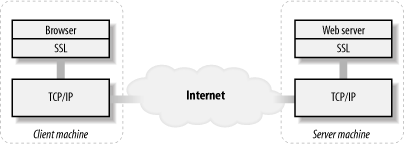As shown in Figure 9-4, The SSL protocol operates as a layer between the browser and the TCP/IP services provided by the host. A browser passes the HTTP message to the SSL layer to be encrypted before the message is passed to the host's TCP/IP service. The SSL layer, configured into the web server, decrypts the message from the TCP/IP service and then passes it to the web server. Once SSL is installed and the web server is configured correctly, the HTTP requests and responses are automatically encrypted. There is no scripting required to use the SSL services.
Figure 9-4. HTTP clients and servers, SSL, and the network layer that implements TCP/IP

Because SSL sits between HTTP and TCP/IP, secure web sites technically don't serve HTTP, at least not directly over TCP. URLs that locate resources on a secure server begin with https://, which means HTTP over SSL. The default port for an SSL service is 443, not port 80 as with HTTP; for example, when a browser connects to https://secure.example.com, it makes a TCP/IP connection to port 443 on secure.example.com. Most browsers and web servers can support SSL, but keys and certificates need to be included in the configuration of the server (and possibly the browser, if client certification is required).